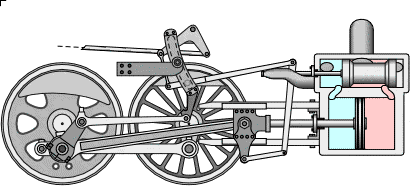
The reversing lever, or "Johnson Bar", does more than simply provide the reverse function of the valve gear. Its control of the cutoff is equally important. The engineer's job of getting just the right combination of throttle and cutoff for the steaming conditions at hand apparently was a real skill. You may read about notching up, hooking back, hooking up, or company notch in the context of economizing the use of steam at speed.
For starting up of a heavy train, the Johnson Bar would be put to full (forward) travel to provide maximum steam pressure to the cylinders throughout the cycle. As the train got up to speed, the Johnson Bar would be gradually brought back (hooked back, notched up, put in the company corner).
IE: Once the train was rolling, setting to a position about 1/3 from dead center would provide the best fuel economy - hence the term company notch - you were saving the company money. This position cuts off the steam admission early in the cycle and allows use of the expansion of the steam, getting most of the energy available from it.
The throttle indeed may even be left full open so that the maximum heat energy of the steam gets to the cylinders and the cutoff of the valve spindle admits just enough to maintain speed by utilizing the steam in an efficient a manner as possible, using all of the expansion energy.
From http://home.roadrunner.com/~trumpetb/loco/rodsr.html
Nice informative blog.
ReplyDeletewe are manufacturer of bucket elevators in India.Please visit for details
1. Bucket Elevators
2.Centrifugal Discharge Bucket Elevators
3 Continuous Discharge Bucket Elevtors
4.Bucket Elevtors for Bulk materilas handling